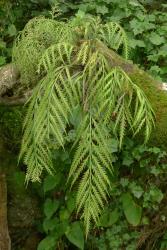- ≡ Caenopteris flaccida (G.Forst.) Thunb., Nova Acta Acad. Sci. Imp. Petrop. Hist. Acad. 9: 158, t. D, f. 1–2 (1795)
- ≡ Darea flaccida (G.Forst.) Willd., Sp. Pl. 5(1), 295 (1810)
- ≡ Asplenium marinum var. flaccidum (G.Forst.) F.Muell., Veg. Chatham Isl. 67 (1864)
- ≡ Asplenium bulbiferum var. flaccidum (G.Forst.) Domin, Biblioth. Bot. 20(85): 104 (1913)
- = Caenopteris odontites Thunb., Nova Acta Acad. Sci. Imp. Petrop. Hist. Acad. 9: 159, t. E, f. 1 (1795)
- ≡ Darea odontites (Thunb.) Willd., Sp. Pl. 5(1), 296 (1810)
- ≡ Asplenium odontites (Thunb.) R.Br., Prodr. Fl. Nov. Holland. 151 (1810)
- = Caenopteris novae-zeelandiae Spreng., J. Bot. (Schrader) 1799(2): 269 (1800)
- = Asplenium heterophyllum A.Rich., Essai Fl. Nouv.-Zél., 74 (1832)
Epiphytic, terrestrial, or rupestral ferns. Rhizomes stout, erect, or short-creeping, bearing scales. Rhizome scales either narrowly ovate with filiform apices and thinner cell walls or ovate to narrowly ovate with thick cell walls, 2–30 mm long, 0.5–2 mm wide, dark brown, clathrate. Fronds 75–1560 mm long. Stipes 20–440 mm long, brown abaxially and proximally, becoming green adaxially and distally, bearing scattered narrowly ovate scales with filiform apices or ovate scales with thickened cell walls. Rachises green, scaly. Laminae 1–2-pinnate-pinnatifid, ovate or elliptic or narrowly elliptic, abruptly narrowed to a pinnatifid apex, 30–1280 mm long, 20–250 mm wide, dull green on both surfaces, coriaceous, limp and pendulous or stiff and upright, bearing scattered scales, lacking hairs. Primary pinnae in 2–26 pairs below pinnatifid apex, not or only slightly overlapping; the proximal pinnae and those at mid-lamina linear to narrowly ovate or ovate; the longest at or below the middle, 16–280 mm long, 3–30 mm wide (excluding basal acroscopic pinnule), apices forming undivided narrowly acuminate segments 2–40 mm long, bases stalked; costae of primary pinnae winged throughout except near junction with rachis. Secondary segments either decreasing slightly in length both distally and proximally along each primary pinna, or the basal acroscopic secondary segment enlarged or extended and further divided; the longest secondary segments linear or oblong or elliptic or ovate, straight or rarely falcate, 2–20 mm long, 0.75–10 mm wide, apices acute or obtuse, bases adnate or decurrent; the basal acroscopic secondary pinna sometimes enlarged or extended up to 100 mm long and 15 mm wide, undivided or bifid or divided into linear or oblong tertiary segments. Sori submarginal; indusia 2–13 mm long, straight; free margins of indusia entire. Mean spore size 30–49 μm long, 21–33 μm wide; perispores sometimes winged but usually lacking ridges.
| 1 | Laminae limp and pendulous; secondary segments on each primary pinna usually undivided and ± equal in length; usually epiphytic plants of forest or sometimes terrestrial | subsp.flaccidum |
| Laminae firm and upright; basal acroscopic segment on each primary pinna usually divided and enlarged; plants of coastal areas in northern New Zealand | subsp.haurakiense |
Asplenium flaccidum is most easily confused with A. appendiculatum but can be distinguished by its tetraploid chromosome number, less divided frond, and the less prominently ridged spore pattern (see Brownsey 1977b; Large & Braggins 1991).
Asplenium flaccidum has two distinct forms, which were recognised as separate subspecies by Brownsey (1977b). The differences between them are described below under A. flaccidum subsp. flaccidum.
North Island: Northland, Auckland, Volcanic Plateau, Gisborne, Taranaki, Southern North Island.
South Island: Western Nelson, Sounds-Nelson, Marlborough, Westland, Canterbury, Otago, Southland, Fiordland.
Kermadec Islands, Three Kings Islands, Chatham Islands, Solander Island, Stewart Island, Auckland Islands.
Altitudinal range: 0–1525 m.
Asplenium flaccidum occurs on the Kermadec Islands and the Three Kings Islands, and is widely distributed throughout coastal, lowland and montane areas of the North Island. It grows from sea level to 1100 m in the Kaimanawa Ranges. In the South Island it occurs mostly frequently in lowland to subalpine areas west of the main divide, growing from near sea level to over 1500 m on Mt Arthur, with only scattered populations on the east coast and in inland Canterbury. It extends to Stewart Island, the Chatham Islands and Auckland Islands.
Also Australia (Queensland, New South Wales, Victoria, Tasmania).
Asplenium flaccidum usually grows as an epiphyte in kauri, podocarp, beech, and broadleaved forest, and under mānuka, kānuka and low scrub, as well as on aerial roots, rotten trunks and stumps. It sometimes grows on rocks, mossy banks, stream banks, thermally heated soil, on the ground under Cupressus macrocarpa and Pinus, and on coastal rocks within the immediate vicinity of salt spray, or in coastal scrub and coastal pōhutukawa or karaka forest.
| Category | Number |
|---|---|
| Indigenous (Endemic) | 1 |
| Indigenous (Non-endemic) | 1 |
| Total | 2 |
There is evidence that A. flaccidum hybridises with A. appendiculatum subsp. appendiculatum, A. appendiculatum subsp. maritimum, A. bulbiferum, A. hookerianum, A. oblongifolium, A. obtusatum, A. scleroprium (Brownsey 1977a), A. gracillimum, A. lyallii (de Lange et al. 2011), A. lepidotum (Perrie & Brownsey 2016), A. chathamense, A. decurrens and A. shuttleworthianum (newly recorded here).
n = 72 (Brownlie 1954; Brownsey 1977b).
Analysis of low-copy nuclear DNA sequences suggests that an Asplenium flaccidum-like lineage is a tetraploid parent of the three allopolyploid species A. appendiculatum, A. scleroprium, and A. shuttleworthianum (Shepherd et al. 2008). The genetic evidence suggests that A. flaccidum subsp. haurakiense is the more likely parent for A. scleroprium, but this is contradicted by the present-day distributions of the two taxa, which do not overlap.




